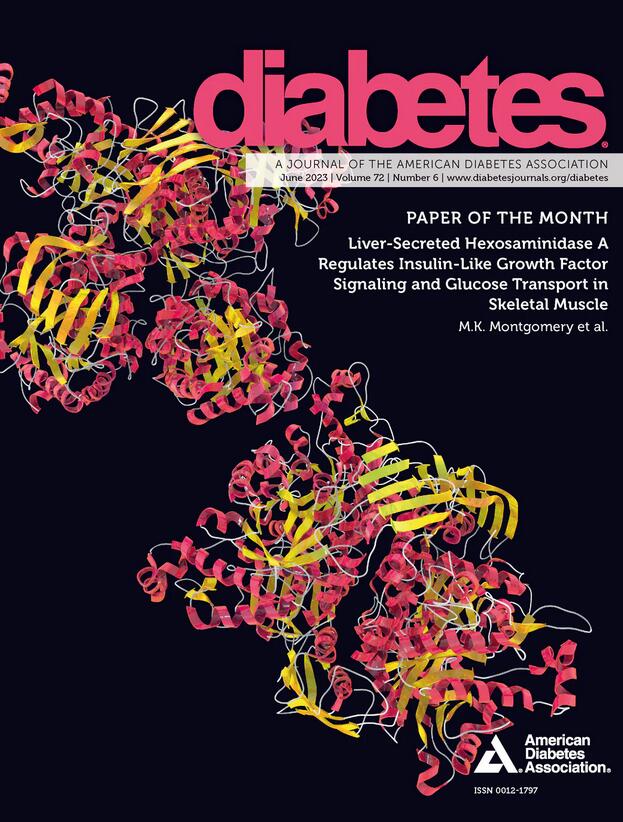联合减肥和运动训练改变骨骼肌亚细胞脂质定位和肌间脂肪组织细胞组成
IF 7.5
1区 医学
Q1 ENDOCRINOLOGY & METABOLISM
引用次数: 0
摘要
亚细胞脂质积累和肌间脂肪组织(IMAT)积累与胰岛素抵抗有关,但联合减肥和运动训练对脂质定位和IMAT细胞组成的影响尚不清楚。21名肥胖成人(女性18名,男性3名;46±2岁;35.0±0.9 kg/m2)完成了为期3个月的监督减肥和运动训练干预。采用高胰岛素-正血糖钳测量胰岛素敏感性,并在干预前后收集基础和胰岛素刺激的股外侧肌活检。干预后,体重和体脂下降(分别为11±1%和9±1%),VO2峰值和胰岛素敏感性升高(分别为14±3%和68±14%)。脂质组学显示肌上皮和核甘油三酯减少,全肌肉甘油三酯不变。在没有PKCε、PKCθ或PKCδ活化的情况下,核1,2-二酰基甘油增加导致全肌二酰基甘油增加。全肌鞘脂水平因胞浆积累而增加。单核RNA测序显示IMAT细胞组成改变,包括纤维脂肪祖细胞、血管细胞和巨噬细胞增加,前脂肪细胞减少。大肌肉RNA测序显示,与肌肉重塑和细胞呼吸相关的基因上调,干预后核二酰基甘油与基因表达的关系发生变化。这些发现将胰岛素敏感性的改善与总肌二酰基甘油和鞘脂水平分离,并强调了亚细胞脂质再分配和IMAT重塑在胰岛素敏感化中的作用。亚细胞分离肌肉的评估显示,干预后肌层和核甘油三酯减少,核二酰基甘油和胞浆鞘脂增加。体重减轻揭示了肌间脂肪组织的细胞组成的改变以及与肌肉重塑和细胞呼吸相关的基因的上调。这些发现将胰岛素敏感性的改善与总肌肉1,2-二酰基甘油和鞘脂水平分离开来,并强调了肌间脂肪组织重塑对胰岛素敏感性增强的作用。本文章由计算机程序翻译,如有差异,请以英文原文为准。
Combined Weight Loss and Exercise Training Alters Skeletal Muscle Subcellular Lipid Localization and Intermuscular Adipose Tissue Cellular Composition
Subcellular lipid accumulation and intermuscular adipose tissue (IMAT) accumulation are associated with insulin resistance, but the impact of combined weight loss and exercise training on localization of lipids and IMAT cellular composition is not known. Twenty-one adults with obesity (18 female and 3 male; 46 ± 2 years; 35.0 ± 0.9 kg/m2) completed a 3-month supervised weight loss and exercise training intervention. Insulin sensitivity was measured using a hyperinsulinemic-euglycemic clamp, and basal and insulin-stimulated vastus lateralis biopsies were collected pre- and postintervention. After the intervention, body weight and body fat decreased (11 ± 1% and 9 ± 1%, respectively), while VO2 peak and insulin sensitivity increased (14 ± 3% and 68 ± 14%, respectively). Lipidomics revealed reduced sarcolemmal and nuclear triglycerides, with unchanged whole-muscle triglycerides. Whole-muscle diacylglycerols increased because of increased nuclear 1,2-diacylglycerols without PKCε, PKCθ, or PKCδ activation. Whole-muscle sphingolipid levels increased because of cytosolic accumulation. Single-nuclei RNA sequencing showed altered IMAT cellular composition, including increased fibro-adipogenic progenitors, vascular cells, and macrophages, and decreased preadipocytes. Bulk muscle RNA sequencing indicated upregulation of genes related to muscle remodeling and cellular respiration, and there were changes in the relationship between nuclear diacylglycerols and gene expression postintervention. These findings dissociate improvements in insulin sensitivity from total muscle diacylglycerol and sphingolipid levels and highlight roles for subcellular lipid redistribution and IMAT remodeling in insulin sensitization. Article Highlights Evaluation of subcellular fractionated muscle revealed decreases in sarcolemmal and nuclear triglycerides and increases in nuclear diacylglycerols and cytosolic sphingolipids postintervention. Weight loss revealed alteration in the cellular composition of intermuscular adipose tissue and upregulation of genes related to muscle remodeling and cellular respiration. These findings dissociate improvements in insulin sensitivity from total muscle 1,2-diacylglycerol and sphingolipid levels and highlight roles of intermuscular adipose tissue remodeling for enhanced insulin sensitivity.
求助全文
通过发布文献求助,成功后即可免费获取论文全文。
去求助
来源期刊

Diabetes
医学-内分泌学与代谢
CiteScore
12.50
自引率
2.60%
发文量
1968
审稿时长
1 months
期刊介绍:
Diabetes is a scientific journal that publishes original research exploring the physiological and pathophysiological aspects of diabetes mellitus. We encourage submissions of manuscripts pertaining to laboratory, animal, or human research, covering a wide range of topics. Our primary focus is on investigative reports investigating various aspects such as the development and progression of diabetes, along with its associated complications. We also welcome studies delving into normal and pathological pancreatic islet function and intermediary metabolism, as well as exploring the mechanisms of drug and hormone action from a pharmacological perspective. Additionally, we encourage submissions that delve into the biochemical and molecular aspects of both normal and abnormal biological processes.
However, it is important to note that we do not publish studies relating to diabetes education or the application of accepted therapeutic and diagnostic approaches to patients with diabetes mellitus. Our aim is to provide a platform for research that contributes to advancing our understanding of the underlying mechanisms and processes of diabetes.
 求助内容:
求助内容: 应助结果提醒方式:
应助结果提醒方式:


